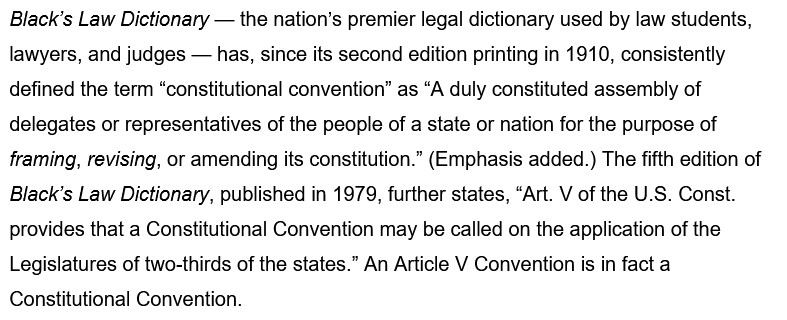My Congressman from the 5th District of Arizona, Andy Biggs, published a book in 2014 titled “The Con of the Con Con: The Case Against the States Amending the U.S. Constitution.”
He argued that we shouldn’t tinker with the Constitution by holding an Article V convention to alter it. His views align with the John Birch Society, a group that wants to defend the Constitution by educating the electorate about its merits and stopping efforts to change it via an Article V convention.
We the People have become more knowledgeable about Article V of the Constitution thanks to organizations such as the Convention of States Action and the Article V Information Center. We must continue to push back on Andy Biggs and the John Birchers, who perpetuate their deceptions, their CONS.
What is a Convention of States?
"Conventions of states are sometimes known by other names. Conventions meeting before the establishment of the Second Continental Congress were usually called “congresses”—although they were also called conventions. Some gatherings have been called “councils” or “committees,” as well as conventions.. Similarly, twentieth-century conventions have been called “commissions” (e.g., Colorado River Compact Commission). But they actually were temporary conventions of states. They should not be confused with those commissions that are permanent administrative bodies."
The truth is:
- There have been 42 Conventions of States since 1677.
- There has never been a convention for proposing amendments under Article V, but there is ample precedent for conducting a Convention of States.
Con #1 – Article V, “a convention for proposing amendments,” is a Constitutional Convention

Using this definition, it must also be true that a Constitutional Convention occurs when Congress proposes amendments.
In other words, what were the editor’s assumptions when they put this definition into the “premier” law dictionary?
- Was the 1910 edition influenced by ideas during the progressive era?
- Was the 1979 edition in response to the unprecedented number of states calling for a Balanced Budget Amendment during the 1970s?
The truth is:
- There has been only one Constitutional Convention in the history of the United States (two if you count the Confederate one in 1861). There is no need for another one.
- An Article V convention for proposing amendments is a convention where the U.S. Congress plays only a ministerial duty to name a place and a time.
Con #2 – The precedent for an Article V Convention is the 1787 Constitutional Convention, which went beyond its original purpose to merely revise the Articles of Confederation
The truth is:
- To be clear, Article V did not exist at the start of the 1787 convention.
- The call for the convention resulted from the Annapolis Convention of 1786, formally titled a “Meeting of Commissioners to Remedy Defects of the Federal Government” - a “Convention of States.”
- Indeed, many delegates thought they were there to make a few changes to the Articles of Confederation. But, it soon became apparent that a major rewrite was needed. Read it here and judge for yourself. We, as computer programmers, would call it spaghetti code.
- The Articles was a beta version of the Constitution that needed a complete rewrite.
Con #3 – No rules exist for conducting a Convention of States under Article V (e.g., scope, selection of delegates, etc.)
Truth is, there has been a lot of progress:
- A formal method for memorializing Applications and Rescissions under Article V has been established by Congress. Here is the list.
- Convention of States Action has led the effort to define a specific topic for the convention that 19 states have agreed to in their applications. Here is Arizona’s application.
- In 2017, Arizona hosted a convention for the purpose of: Creating a single point of contact in tracking applications for a Balanced Budget Amendment convention; Monitoring Article V efforts; and working with Congress to suggest a time and place for the BBA convention.


